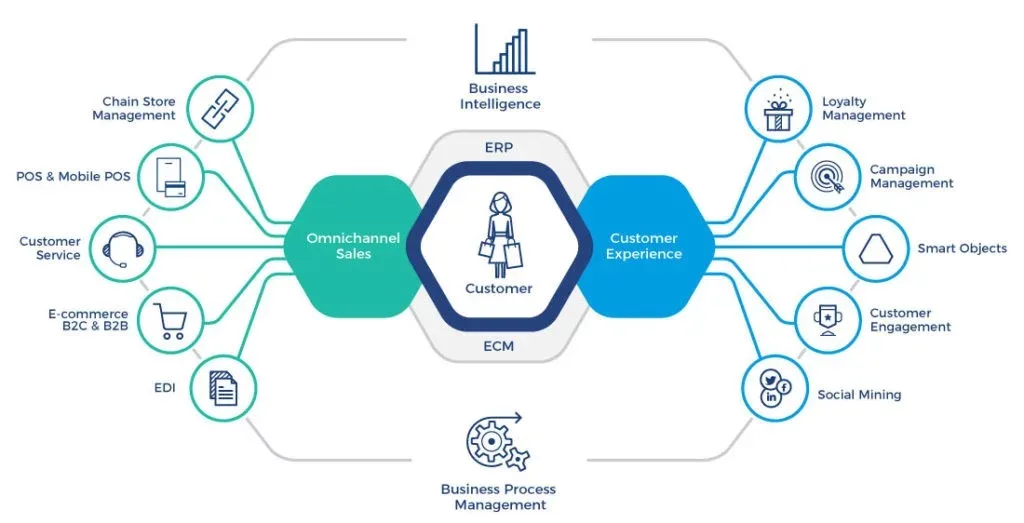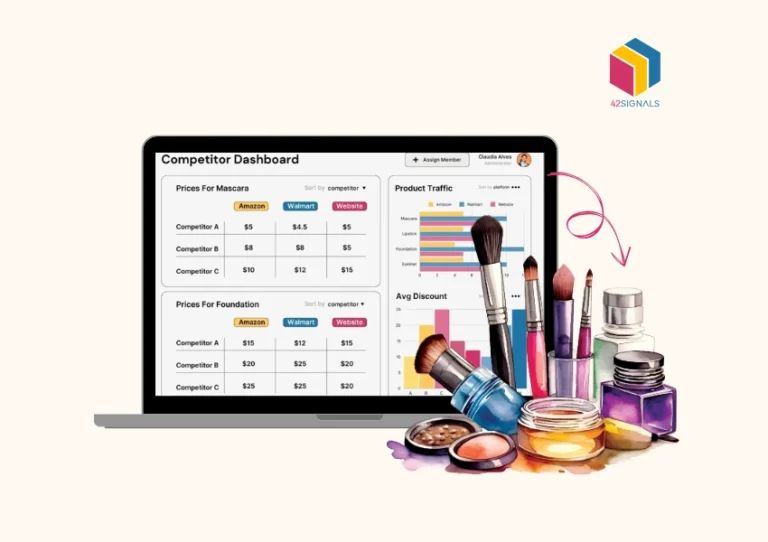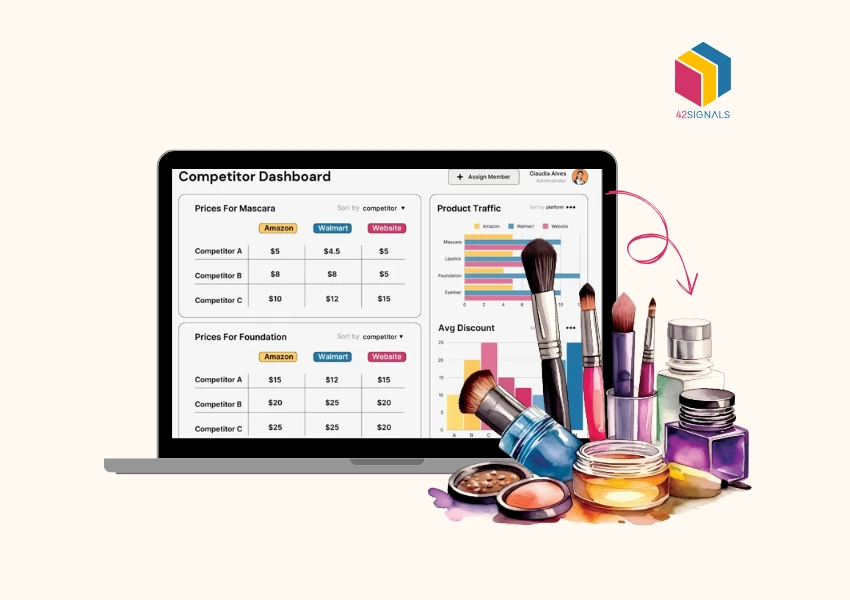In today’s rapidly evolving digital marketplace, e-commerce brands are not just participants but pioneers in shaping consumer trends and preferences. As the digital landscape continuously reshapes itself, staying ahead in the game is not merely a matter of choice but of survival and growth. This is where e-commerce market intelligence steps in, guiding brands toward informed decision-making and strategic foresight.
Image: E-commerce market intelligence

Source: https://www.vservesolution.com/data-intelligence/
E-commerce market intelligence is more than just gathering data; it’s about making sense of this data to predict trends, understand consumer behavior, and outmaneuver competitors. In an age where information is power, the ability to analyze and utilize this information effectively becomes the cornerstone of success. It’s not just about having information but about knowing what to do with it.
From small startups to global giants, businesses are increasingly relying on sophisticated market intelligence tools and techniques to stay relevant and competitive. These tools offer a treasure trove of insights – from understanding minute shifts in consumer preferences to predicting larger market trends. The challenge, however, lies in not just accessing this intelligence, but in translating it into actionable strategies that drive growth and innovation.
In this article, we dive into eight best practices that can help e-commerce brands effectively harness the power of market intelligence. We will explore how brands can leverage data-driven insights, refine their competitor analysis, integrate customer feedback, and much more, all while keeping an eye on the future with predictive analytics and technological innovations.
We will also see how integrating a platform like 42Signals can provide a significant edge in this intelligence-driven race. With its advanced analytics and customer insight tools, 42Signals is more than just a service provider; it’s a partner in navigating the complex e-commerce landscape.
Leverage Data-Driven Insights with E-Commerce Market Intelligence
In the realm of e-commerce, knowledge is not just power, it’s the driver of innovation and success. Understanding customer preferences and market trends is the linchpin in this dynamic environment. This is where the magic of data-driven insights comes into play.
Imagine being able to predict the next big trend in your industry before it takes off. Or, understanding exactly what motivates your customers’ purchasing decisions. This isn’t just a hypothetical scenario but a tangible reality made possible through data analytics. With tools like 42Signals’ analytics platform, this kind of foresight is within reach.
42Signals goes beyond mere data collection; it interprets vast amounts of information to identify emerging trends, empowering brands to not just respond to market changes but to anticipate them.
Competitor Analysis

Source: https://klue.com/blog/gathering-competitive-intelligence
Knowing your opponent’s next move is as vital as planning your own. This is where competitor analysis comes into the spotlight, serving as a critical element in crafting a winning strategy. By keeping a close eye on your competitors, you gain invaluable insights into what they’re doing right, their missteps, and, most importantly, opportunities for your brand to capitalize on.
Competitor analysis isn’t just about observing; it’s about understanding the subtleties of your rivals’ strategies. It encompasses everything from their product offerings and pricing models to their marketing tactics and customer service approach. With tools like 42Signals, you have access to a comprehensive suite of analytics that dissects these aspects in depth.
Customer Feedback Integration
In the world of e-commerce, your customers are more than just your audience; they are your best critics and your most honest advisors. Integrating customer feedback into your business model is not just a practice; it’s an essential strategy for growth and improvement. The key lies in actively listening to what your customers say and using these insights to refine your products, services, and overall customer experience.
Consider customer feedback as a goldmine of information. Each review, comment, or survey response offers a glimpse into what your customers love, what they expect, and where they feel you could do better. This feedback is a direct line to understanding your market and should be a cornerstone in shaping your business strategies.
But how do you efficiently gather and make sense of this vast array of feedback? This is where real-time customer feedback analysis tools come into play. Advanced platforms, such as 42Signals, offer sophisticated methods to collect, analyze, and interpret customer feedback across various channels – be it social media, your website, or email surveys.
Agile Decision-Making with E-Commerce Market Intelligence
In the ever-evolving landscape of e-commerce, agility isn’t just an advantage; it’s a necessity. The ability to make quick, informed decisions can be the difference between capitalizing on a fleeting opportunity and missing the boat entirely. This agility in decision-making is powerfully fueled by real-time data, allowing businesses to respond swiftly and effectively to changing market dynamics and consumer behaviors.
Predictive Analytics
In the dynamic realm of e-commerce, the ability to forecast future trends is not merely a skill—it’s an indispensable tool for staying ahead of the curve. Predictive analytics, a sophisticated blend of data, statistical algorithms, and machine learning techniques, empowers brands to not just react to market changes and customer needs, but to anticipate them.

Predictive analytics transforms historical and current data into a forward-looking perspective. This involves analyzing patterns in consumer behavior, purchasing histories, market trends, and even social media sentiment to predict future outcomes. The power of this approach lies in its ability to provide actionable insights, allowing brands to make strategic decisions that are proactive rather than reactive.
Optimized Pricing Strategies
Pricing is not just a number—it’s a pivotal element that can significantly influence the success of your business. The art of pricing lies in finding that sweet spot where value meets perception, a point where your product is neither undervalued nor priced out of the market. This is where optimized pricing strategies, informed by market intelligence, play a crucial role.
The traditional approach to pricing often involves static pricing models, where prices are set based on costs and a fixed profit margin. However, in the dynamic world of e-commerce, such static models are quickly becoming obsolete. Enter dynamic pricing—a strategy that allows prices to fluctuate based on market demand, competition, customer behavior, and other external factors.
Enhanced Customer Experience
In the digital age, where countless options are just a click away, the customer experience you offer can set you apart from the competition. It’s not just about the products you sell, but how you sell them. This is where enhancing customer experience through personalized interactions becomes key. Utilizing market intelligence to tailor the customer journey transforms generic interactions into memorable, bespoke experiences that foster loyalty and engagement.
Embrace Technological Innovations
Stay abreast of technological advancements. Incorporating AI, AR, and VR can transform the shopping experience. For instance, 42Signals’ AI-driven tools can offer personalized shopping experiences, setting your brand apart.
In Summary of E-Commerce Market Intelligence
Incorporating these best practices in your e-commerce strategy can lead to significant advantages. With tools like those offered by 42Signals, you can not only keep up but set the pace in the ever-evolving e-commerce landscape. Reach out to us at sales@42signals.com for a custom demo.







